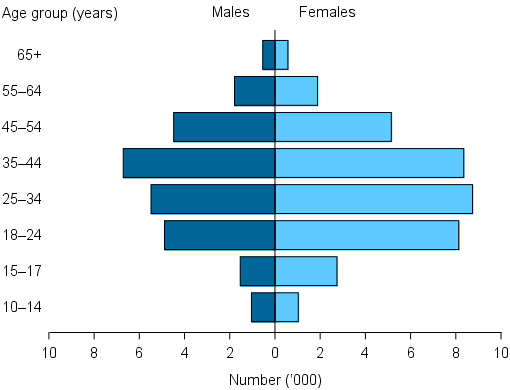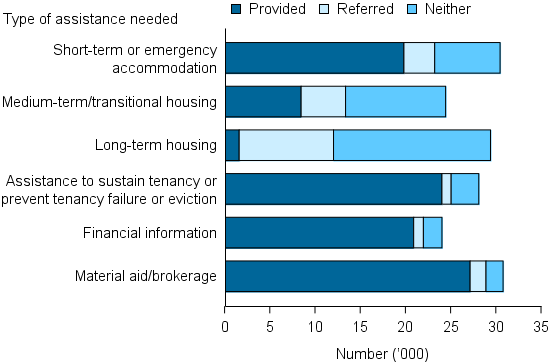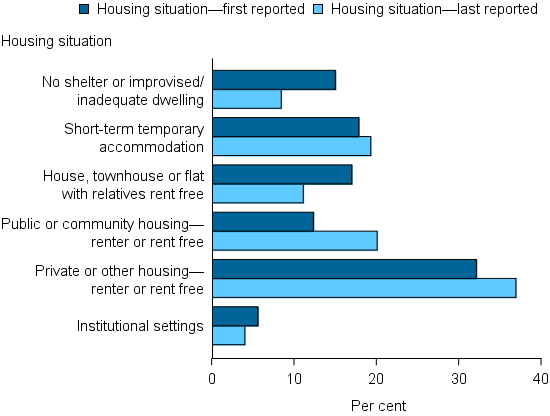Clients with a current mental health issue
In 2014–15, 1 in 4 clients, or 63,000 people, who received assistance from a specialist homelessness agency were identified as having a current mental health issue.
Clients with a current mental health issue: trends over time
The number of clients presenting with a current mental health issue has been increasing since the beginning of the SHS collection in 2011–12. Key trends identified over the 4 years to 2014–15 have been:
- Clients with a current mental health issue are the fastest growing client group within the SHS population, growing at an average annual rate of 12% per year. This increase is likely to be due to a number of factors possibly including increased identification and reporting of mental illness among clients.
- These clients consistently need longer periods of support compared with the broader SHS population.
- Domestic and family violence and housing crisis remain the most common main reason these clients seek assistance from specialist homelessness agencies.
In 2014–15 changes occurred in the way agencies are required to report 'main reason' and 'reasons for seeking assistance'. Comparisons over time should be made with caution as the reporting of housing crisis, financial difficulties and housing affordability stress may be inconsistent between agencies. See Technical information for further details.
| 2011–12 | 2012–13 | 2013–14 | 2014–15 | |
|---|---|---|---|---|
| Number of clients (proportion of all clients) | 44,835 (19%) | 48,599 (20%) | *56,301 (22%) | 63,062 (25%) |
| Rate (per 10,000 population) | 20 | 21 | 24 | 27 |
| Housing situation at the beginning of first support period (all clients) | ||||
| Homeless: At risk of homelessness | 49%: 51% | *51%: 49% | *50%: 50% | 50%: 50% |
| Living arrangement | ||||
| Lone person | 47% | 48% | 48% | 46% |
| Sole parent | 21% | 21% | 22% | 22% |
| Couple with child/ren | 7% | 7% | 7% | 8% |
| Couple without children | 5% | 5% | 5% | 6% |
| Other family group | 19% | 19% | 18% | 18% |
| Main reason for seeking assistance (Top 4) | ||||
| Housing crisis | 15% | 16% | 18% | 24% |
| Domestic and family violence | 17% | 15% | *16% | 16% |
| Financial difficulties | 11% | 12% | 12% | 11% |
| Inadequate or inappropriate dwelling conditions | 10% | 12% | 12% | 12% |
| Proportion receiving accommodation (median (nights)) | 49% (49) | 48% (48) | *44% (48) | 42% (44) |
| Number of support periods (average per client) | 98,273 (2.2) | 115,949 (2.4) | 128,820 (2.3) | 144,799 (2.3) |
| Average (median) length of support (days) | 121 (67) | 128 (73) | *119 (67) | 109 (62) |
| Proportion of a client group with a case management plan | 71% | *69% | *69% | 70% |
| Achievement of all case management goals | 14% | 15% | *18% | 19% |
Notes
-
Rates are crude rates based on the Australian estimated resident population (ERP) at 30 June of the reference year.
-
* Indicates where previously published data have been revised to ensure consistent reporting over time. 2011–12 data were revised in December 2013 but not previously reported in this format.
-
The denominator for the proportion achieving all case management goals is the number of client groups with a case management plan. Denominator values for proportions are provided in the relevant national supplementary table.
Source: Specialist homelessness services Annual Reports 2011–12, 2012–13, 2013–14 and 2014–15.
Age and sex
Similar to the broader SHS population, the majority of clients with a current mental health issue were female (58%). Nearly half of all clients with a current mental health issue (46%, or 29,300), were aged between 25 and 44 (Figure MH.1).
Figure MH.1: Clients with a current mental health issue, by age and sex, 2014–15

Source: Specialist homelessness services 2014–15, National supplementary table MH.1 (702KB XLS).
About 30,000
clients with a current mental health issue needed short term or emergency accommodation; 65% were provided assistance.
Of those clients with a current mental health issue, almost 20,000 identified a need for mental health based services with:
- twenty-seven per cent identifying a need for mental health services
- twelve per cent identifying a need for psychological services
- seven per cent identifying a need for psychiatric services.
Compared with the general SHS population, clients with a current mental health issue were more likely to identify a need for:
- drug and alcohol services (11% compared with 4% of the general SHS population).
- health/medical services (23% compared with 10% of the broader SHS population)
- long-term housing (47% compared with 33% of the general SHS population).
High proportions of clients with a current mental health issue also identified as needing:
- material aid/brokerage (49% or over 30,000 clients); with assistance provided to 88% of these clients
- financial information (38% or over 24,000 clients); with assistance provided to 87% of these clients
- transport (34%); with assistance provided to 94% of these clients (Figure MH.2).
Figure MH.2: Clients with a current mental health issue, by top 6 most needed services and service provision status, 2014–15

Note: Excludes 'Other basic assistance', 'Advice/information', and 'Advocacy/liaison on behalf of client'.
Source: Specialist homelessness services 2014–15, National supplementary table MH.3 (702KB XLS).
For clients with a current mental health issue and who had closed support:
- 50% (or about 21,000) were homeless at the beginning of support, and this decreased to 39% at end of support
- improvement in housing outcomes was particularly evident for clients who first presented with having no shelter or improvised/inadequate dwelling, with 15% of clients with this housing situation at the beginning of support compared with 8% at the end of their support (Table MH.4).
Most clients were housed at the end of support with (Figure MH.3):
- thirty-seven per cent (or nearly 15,000 clients) in private rental (increased from 32%)
- twenty per cent (or about 8,000 clients) in public/community housing (an increase from 12%).
Figure MH.3: Clients with a current mental health issue and who had closed support, by housing situation at the beginning and end of support, 2014–15

Source: Specialist homelessness services 2014–15, National supplementary table MH.4 (702KB XLS).


